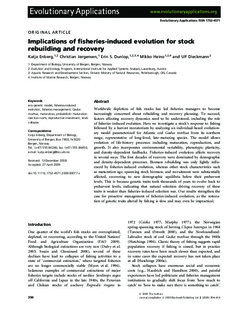| dc.description.abstract | Worldwide depletion of fish stocks has led fisheries managers to become increasingly concerned about rebuilding and recovery planning. To succeed, factors affecting recovery dynamics need to be understood, including the role of fisheries-induced evolution. Here we investigate a stock’s response to fishing followed by a harvest moratorium by analyzing an individual-based evolutionary model parameterized for Atlantic cod Gadus morhua from its northern range, representative of long-lived, late-maturing species. The model allows evolution of life-history processes including maturation, reproduction, and growth. It also incorporates environmental variability, phenotypic plasticity, and density-dependent feedbacks. Fisheries-induced evolution affects recovery in several ways. The first decades of recovery were dominated by demographic and density-dependent processes. Biomass rebuilding was only lightly influenced by fisheries-induced evolution, whereas other stock characteristics such as maturation age, spawning stock biomass, and recruitment were substantially affected, recovering to new demographic equilibria below their preharvest levels. This is because genetic traits took thousands of years to evolve back to preharvest levels, indicating that natural selection driving recovery of these traits is weaker than fisheries-induced selection was. Our results strengthen the case for proactive management of fisheries-induced evolution, as the restoration of genetic traits altered by fishing is slow and may even be impractical. | en_US |
